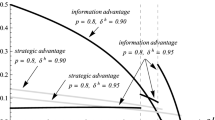Abstract
This study investigates the impact of two alternative forms of arbitration — conventional arbitration and final-offer arbitration — and whether or not prearbitration bargaining information is available to the arbitrator on negotiation behavior and outcomes. Contrary to Wheeler’s prediction, participants anticipating closed-offer arbitration neither conceded more nor reached more settlements than did participants anticipating open-offer arbitration. Participants anticipating final-offer arbitration made a greater final concession than did participants anticipating conventional arbitration.
Similar content being viewed by others
References
Anderson, John C. “The Impact of Compulsory Arbitration: A Methodological Assessment.”Industrial Relations 20 (Spring 1981): 129–48.
Champlin, Frederick C. and Mario F. Bognanno. “Chilling Under Arbitration and Mixed Strike-Arbitration Regimes.”Journal of Labor Research 6 (Fall 1985): 375–87.
DeNisi, Angelo S. and James B. Dworkin. “Final-Offer Arbitration and the Naive Negotiator.”Industrial and Labor Relations Review 35 (October 1981): 78–87.
Feigenbaum, Charles. “Final-Offer Arbitration: Better Theory Than Practice.”Industrial Relations 14 (October 1975): 311–17.
Feuille, Peter. “Final-Offer Arbitration and the Chilling Effect.”Industrial Relations 14 (October 1975): 302–10.
_____. “Selected Benefits and Costs of Compulsory Arbitration.”Industrial and Labor Relations Review 33 (October 1979): 64–76.
Grigsby, David W. and William J. Bigoness. “Effects of Mediation and Alternative Forms of Arbitration Upon Bargaining Behavior.”Journal of Applied Psychology 67 (October 1982): 549–54.
Hirsch, Barry T. and Clifford B. Donn. “Arbitration and Incentive to Bargain: The Role of Expectations and Costs.”Journal of Labor Research 3 (Winter 1982): 55–68.
Kearney, Richard C.Labor Relations in the Public Sector. New York: Marcel C. Dekker, VII, 1984.
Lewin, David. “Public Sector Labor Relations: A Review Essay.”Labor History 18 (Winter 1977): 133–44.
Magenau, John M. “The Impact of Alternative Impasse Procedures on Bargaining: A Laboratory Experiment.”Industrial and Labor Relations Review 36 (April 1983): 361–77.
Neale, Margaret A. and Max H. Bazerman. “The Role of Perspective Taking Ability in Negotiating Under Different Forms of Arbitration.”Industrial and Labor Relations Review 36 (April 1983): 378–88.
Sheppard, Blair H. “Third Party Conflict Intervention: A Procedural Framework.” In Barry M. Staw and Larry L. Cummings, eds.,Research in Organization Behavior. Greenwich, Conn.: JAI Press, Inc., 1984, pp. 141–90.
Stevens, Carl M. “Is Compulsory Arbitration Compatible with Bargaining?”Industrial Relations 5 (February 1966): 38–52.
Wheeler, Hoyt N. “Closed-Offer: Alternative to Final-Offer Selection.”Industrial Relations 16 (May 1977): 298–305.
_____ “How Compulsory Arbitration Affects Compromise Activity.”Industrial Relations 17 (February 1978): 80–84.
Author information
Authors and Affiliations
Rights and permissions
About this article
Cite this article
DuBose, P.B., Bigoness, W.J. A test of Wheeler’s closed-offer arbitration system: An experimental study. Journal of Labor Research 8, 385–393 (1987). https://doi.org/10.1007/BF02685221
Issue Date:
DOI: https://doi.org/10.1007/BF02685221




